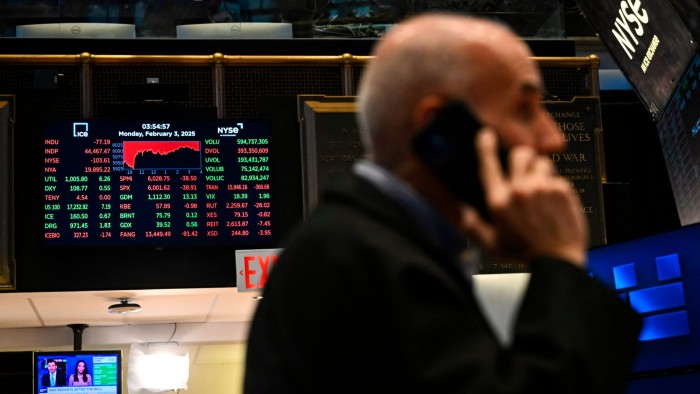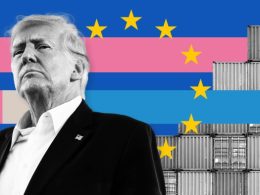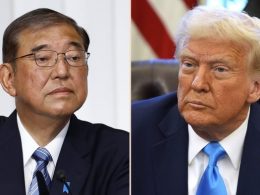Latest news on ETFs
Visit our ETF Hub to find out more and to explore our in-depth data and comparison tools
The exchange traded fund industry blasted through previous records last year, racking up $1.5tn in inflows, 95 per cent of which went into equity and fixed-income funds, but 2025 could look very different, industry observers say.
With threats of tariffs and potential trade wars, and rapid changes to the geopolitical situation, nerves are being stretched tight and the appeal of moving beyond traditional buy-and-hold portfolio building blocks is likely to grow, industry figures say, even if that appeal is misguided.
“Investors should be wary of trying to catch a wave, it might not last,” said Bibb Strench, co-founder of ETF Bild, an ETF think-tank, and partner at law firm Thompson Hine.
Sam Rines, macrostrategist for model portfolios at WisdomTree, was in agreement.
“Things are going to move so fast that you won’t know how to react,” Rines said. “So don’t react.”
Even if investors agree with strategic thinkers such as Strench and Rines, who recommend sticking to long-term underlying trends, there is debate as to whether these trends have now changed. There are also important nuances to consider.
One consideration, for example, is the fact that other market participants may not follow the buy-and-hold advice.
“Market participants do not seem to have the intestinal fortitude to guess at which way the tariff trade will resolve, and therefore will continue to trade the headlines,” said Jake Hanley, senior portfolio strategist at Teucrium, which specialises in agricultural commodity ETFs.
An indication of how hard it might be to correctly identify longer-term trends can be found in Teucrium’s niche corner of the market. Hanley said that while he could see downside to the price of corn and soyabeans if Mexico and China issued retaliatory tariffs on US imports, he also pointed out that these critical food items had limited supply, so the US, which was a major supplier, would eventually find new buyers.
The fortunes of artificial intelligence stocks such as Nvidia during January provide another example. Billions were wiped off the value of the US-listed semiconductor company when a Chinese AI company DeepSeek announced a breakthrough rivalling ChatGPT, reportedly produced at a fraction of the cost and without heavy reliance on expensive chips. So a long-term conviction on AI might still require attentiveness to changes within the AI sector.
The behaviour of other market participants will also provide opportunities in speculative parts of the ETF industry. Douglas Yones, chief executive of leveraged ETF specialist Direxion, said the volatility that would come from trading headlines would benefit its stable of ETFs, which were designed to reset daily and were suitable, therefore, only for investors who wanted to express views over that time period.
“This is direction weather,” Yones said, pointing to the huge jump in interest that accompanied the market turmoil witnessed at the start of the Covid-19 pandemic.
For the three months prior to the World Health Organization’s declaration of the pandemic on March 11 2020, Direxion had inflows of $1.65bn. In the three months afterwards, this leapt to $5.83bn, Yones said.
“As we start 2025, it is worthwhile to pause and reflect on the rapidly rising complexity of the ETF industry,” said Aniket Ullal, head of ETF research at CFRA, in a recent report.
He pointed out that 40 per cent of new ETF listings in the US in 2024 used derivatives as a key component of their strategy, up from 20 per cent in 2014. Not all of these products increased risk for investors — about 40 per cent of those derivatives-based listings were buffered ETFs, where investors can sell some potential upside in exchange for a degree of downside protection.
But nearly a quarter of the launches were broad-based leveraged or inverse products, and 9 per cent were leveraged ETFs focused on single stocks “which by definition are more volatile”, Ullal said.
“The new ETFs being listed are quite far removed from the industry’s traditional roots in low-cost replication of broad indices,” he added.
ETF investors largely stuck to their traditional guns last year, however. Derivatives-based ETFs accounted for 27 per cent of the ETFs in the US, but only 7 per cent of the inflows in 2024, according to Ullal.
For investors keen to ignore the noise, Brad Holland, director of investment strategy at JPMorgan-owned digital wealth manager Nutmeg, maintained that holding one’s nerve in the kind of diversified index-based portfolio that was Nutmeg’s own speciality was still the best advice.
Such an approach, Holland argued, would “help investors capture the emerging winners, while potentially softening short-term volatility in specific company holdings which can follow tariff announcements and other statements”.
Factors Nutmeg will be taking into account for investors will include detail on their view of how relations between the US and China will play out.
“Countries that can navigate the US-China divide, like Japan and the UK, are positioned to benefit relative to some others,” Holland said.
For US ETF investors, industry observers agree, the Securities and Exchange Commission is likely to adopt a lighter-touch regulatory approach that could lead to the approval of more crypto and leveraged ETFs.
Whatever approach investors intend to take when deciding what long-term themes they believe make sense and how much money, if any, they want to put to work on short-term bets, now is a good time to reacquaint yourself with what you are holding.
“Investors should be aware what’s in their portfolio and see if it makes sense in relation to their time horizon,” said Strench.
Source link









